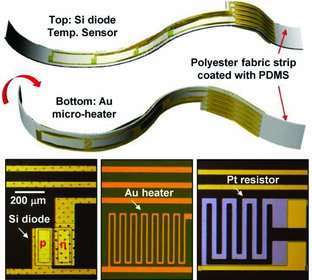August 26, 2012 weblog
Study proposes smart sutures with sensors for wounds

(Â鶹ÒùÔº)—What if sutures could be coated with sensors to monitor wounds and speed healing? A recent study published in the journal Small indicates materials and methods that show it may be part of the medical science future. Researchers working with advanced materials applied to medicine have built "smartened" sutures with ultrathin silicon sensors to measure temperature at a wound site—elevated temperatures indicate infection—and to deliver heat to a wound site to aid healing. The study, published online, is titled "Thin, Flexible Sensors and Actuators as 'Instrumented' Surgical Sutures for Targeted Wound Monitoring and Therapy." The study authors present two types of temperature sensors on the sutures, a silicon diode that shifts current output with temperature, and platinum nanomembrane resistor, changing its resistance with temperature. Gold filaments that heat up when current passes through them serve as the micro-heaters.
explains how the researchers take chemicals to slice off an ultrathin film of silicon from a silicon wafer. With a rubber stamp, they lift and transfer the nanomembranes to polymer or silk strips. They deposit metal electrodes and wires on top and encapsulate the device in an epoxy coating.
The design shape is serpentine to allow for elasticity. As silicon is brittle. the nanomembranes are thin and are laid out in a winding pattern. John A. Rogers, study co-author and professor of materials science and engineering at the University of Illinois at Urbana-Champaign, worked with the study team on the smart sutures. *. Rogers, for some years, has been intrigued by the of "the stretchable" as a next wave in electronics. His research interests include capabilities that can be achieved through stretchable technologies.
The study authors state that "Proper healing of incised skin is critical to the natural processes of tissue repair. Concepts in flexible silicon electronics enable integration of actuators, sensors and a variety of semiconductor devices onto thin strips of plastic or biopolymers, to yield 'instrumented' suture threads for monitoring and accelerating the wound healing in this context. Bifacial systems of this type demonstrate various classes of functionality, in live animal models. Detailed modeling of the mechanics reveals stress and strain distributions in such applications, to support design strategies for robust operation."
MC10, a Cambridge, Massachusetts startup, of which Rogers is cofounder, is working on providing "bend, wrap and stretch" electronics into new form factors. The company has been making use of lab prototypes from Rogers.
The technology presented in Small has been demonstrated on animals. In the animal tests, researchers were able to lace the sutures through skin, pull them tight, and knot them without degrading the devices. The researchers tested both flexibility and toughness on incisions in rat skin.
Rogers, in speaking about future developments, imagines the most value from sutures such as this would be if one could release drugs from them in a programmed way. He said that might be done by coating the electronic threads with drug-infused polymers, which would release chemicals when triggered by heat or an electrical pulse.
More information:
Journal information: Small
© 2012 Â鶹ÒùÔº.Org

















